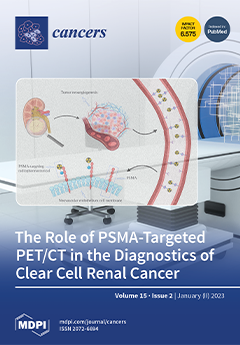Purpose: Chemoembolization of liver lesions, metastatic from colorectal cancer (CRC), with irinotecan-loaded microspheres shows less efficacy if applied after previous systemic chemotherapy. This is because cancer cells acquire resistance to previously used chemotherapeutic agents, e.g., irinotecan or perhaps via, e.g., modulations of
[...] Read more.
Purpose: Chemoembolization of liver lesions, metastatic from colorectal cancer (CRC), with irinotecan-loaded microspheres shows less efficacy if applied after previous systemic chemotherapy. This is because cancer cells acquire resistance to previously used chemotherapeutic agents, e.g., irinotecan or perhaps via, e.g., modulations of EGFR receptors after use of anti-EGFR antibodies.
Objective: To evaluate the effects of prior treatment with anti-EGFR (cetuximab) antibodies on the efficacy of chemoembolization, with irinotecan-loaded microspheres, of liver lesions metastatic from CRC.
Patients and methods: The study included 50 patients (27 female, 23 male) with inoperable liver metastases in the course of CRC who underwent a total of 192 chemoembolization procedures with microspheres loaded with 100 mg of irinotecan. Chemoembolization of the right or left liver lobes was performed alternately at three-week intervals. Patients were divided into two groups: group A (
n = 26): patients who had previously received anti-EGFR (cetuximab) antibodies; and group B (
n = 24): patients who had never received anti-EGFR antibodies. Response to treatment was assessed according to mRECIST criteria. Overall survival time (OS) was calculated using the Kaplan–Meier method. Evaluation of adverse effects was performed according to the Cancer Therapy Evaluation Program Common Terminology Criteria for Adverse Events (Version 5.0).
Results: Analysis did not show a statistically significant difference in radiological response between the two groups: partial response: 36.2% in group A and 32.9% in group B (
p = 0.139); and stable disease: 19.2% in group A and 21.7% in group B (
p = 0.224). Post-treatment progression was comparable at 46.2% in group A and 41.6% in group B (
p = 0.343). There was a significant difference in OS (
p = 0.043 log-rank test), however, prior treatment with cetuximab showed no significant effect on OS in a Cox proportional hazards regression model HR 1.906 (0.977–3.716),
p = 0.058. Mean OS was 15.2 months (95% confidence interval (Cl): 6 to 23 months) in group A and 13.1 months (95% Cl: 7 to 22 months) in group B. In both groups, there was a negative correlation between carcinoembryonic antigen (CEA) levels below 10 mg/mL before surgery and OS (hazard ratio (HR) 0.83 (0.47–8.43),
p = 0.005 in group A and HR 1.02 (0.56–7.39),
p = 0.003 in group B). There was no significant difference in the number of prominent complications between group A (7 complications) and group B (6 complications),
p = 0.663.
Conclusions: Previous therapy with anti-EGFR antibodies before treatment with irinotecan chemoembolization of liver metastatic lesions did not have a significant effect on radiological response to treatment or post-treatment progression. However, higher baseline levels of CEA (>10 ng/mL) were correlated with worse OS (
p = 0.039).
Full article






